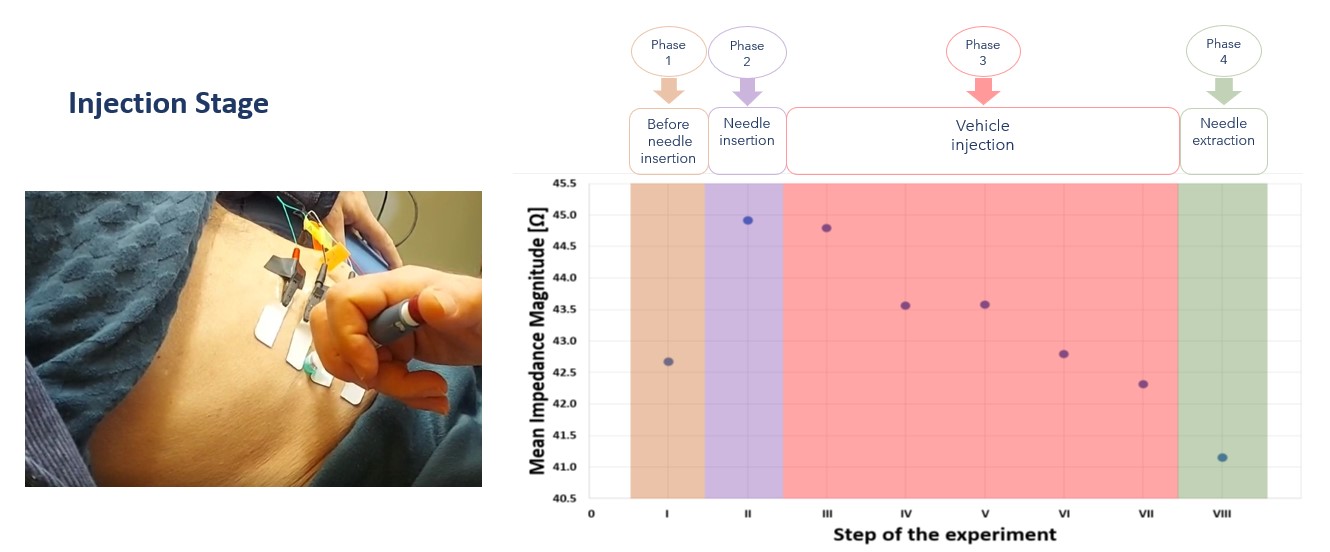
Application field
Diabetology, Orthopedy, and Aesthetic Medicine
Technology
Bio-Impedance spectroscopy, Finite Element Modeling
Goals
Development of innovative methodologies for assessing the effictiveness of topical and transdermal administration of drugs.
The impedance spectroscopy applied to biological tissue is proposed as quantitative method for assessing the dosage in case of transdermal administration.
In case of subcutaneous administration, the method assesses the rate of drug bioavailability to provide immediate evidence on the rapid systemic absorption of a drug (e.g., diabetic patient receiving ultra-fast insulin).
Activities
- Biological tissue modelling (e.g. by finite element simulations) and validated through experimental campaign.
- Classification of different kinds of drugs according their electrical behavior.
- Creation of algorithms for assessing concentration and localization of a drug by elaborating the variation of the impedance spectrum in a biological tissue before and after administration.
- Prototyping of portable and wearable devices able to quantify and localize a drug administered topically or transdermally delivered will be prototyped.
Challenges
- Improving the accuracy and the repeatability of the method
- Mechanical uncertainty sources management
Bibliography
- Balato, M., Petrarca, C., Arpaia, P., Moccaldi, N., Mancino, F., Carleo, G., ... & Balato, G. (2022). Detecting and Monitoring Periprosthetic Joint Infection by Using Electrical Bioimpedance Spectroscopy: A Preliminary Case Study. Diagnostics, 12(7), 1680.
- Arpaia, P., Cuneo, D., Grassini, S., Mancino, F., Minucci, S., Moccaldi, N., & Sannino, I. (2021). A finite element model of abdominal human tissue for improving the accuracy in insulin absorption assessment: A feasibility study. Measurement: Sensors, 18, 100218.
- Annuzzi, G., Arpaia, P., Bozzetto, L., Carleo, G., Cuomo, O., Mancino, F., ... & Taglialatela, M. (2022, June). Measuring insulin absorption by impedance spectroscopy. A feasibility study. In 2022 IEEE International Symposium on Medical Measurements and Applications (MeMeA)(pp. 1-5).
- Arpaia, P., Cuneo, D., Mancino, F., & Moccaldi, N. (2022, May). A Bioimpedance-based Transducer for Insulin Bioavailability Assessment after Subcutaneous Administration. In 2022 IEEE International Instrumentation and Measurement Technology Conference (I2MTC)(pp. 1-5).
- Arpaia, P., Cuneo, D., Mancino, F., Minucci, S., Moccaldi, N., & Sannino, I. Preliminary Investigation of the Impact of Mechanical Stresses on Bioimpedance Spectroscopy-based Insuline Bioavailability Assessment. In 2021 International Workshop on Impedance Spectroscopy (IWIS)(pp. 52-55). IEEE.
- Arpaia, P., Cesaro, U., Frosolone, M., Moccaldi, N., & Taglialatela, M. (2020). A micro-bioimpedance meter for monitoring insulin bioavailability in personalized diabetes therapy. Scientific Reports, 10(1), 1-11.
- Annuzzi, G., Arpaia, P., Cesaro, U., Cuomo, O., Frosolone, M., Grassini, S., ... & Sannino, I. (2020, May). A customized bioimpedance meter for monitoring insulin bioavailability. In 2020 IEEE International Instrumentation and Measurement Technology Conference (I2MTC)(pp. 1-5).
- Arpaia, P., Cuomo, O., Moccaldi, N., Smarra, A., & Taglialatela, M. (2018, August). Non-invasive real-time in-vivo monitoring of insulin absorption from subcutaneous tissues. In Journal of Physics: Conference Series(Vol. 1065, No. 13, p. 132008). IOP Publishing.





